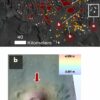Our planet’s surface has seen a thing or two in its 4.5 billion-odd-years of existence. Weathered by ocean, corroded by wind, and remolded by the relentless turnover of plate tectonics, we might assume nothing remains of Earth in its most primitive state.
Yet an analysis of rocks from a formation in Greenland reveals traces of a geological journey that took place at a time when our rocky world was little more than a molten ocean of magma, and it could fill in missing details on our ancient past.
Researchers from the University of Cambridge in the UK and Carleton University in Canada paid particular attention to signature levels of iron isotopes in a powdered sample of basalt taken from the northern parts of the Isua Greenland Belt (ISB).
Along with a study of its tungsten, the chemical signatures reflect the basalt’s birth from a mix of components from different parts of the mantle at a time when Earth’s entirely molten surface was hardening.
The Isua belt is a strip of crust in Greenland’s southwest that has remained relatively unchanged for a mind-blowing 3.7 billion years, officially making them the oldest rocks on Earth.
For more than half a century the ISB has been a regular haunt for planetary scientists and biologists keen to learn more about how our planet’s crust formed, and how its chemistry – including the earliest forms of life – might have emerged.
As old as the belt might be, Earth had already been a planet of sorts for a good half a billion years prior to their formation. Not that we’d recognize it now.
Heated by frequent collisions of new material raining down from space and radioactive materials that hadn’t yet sunk to the planet’s core, there was no crust yet as such – just a churning blob of mineral soup.
We can work that much out by applying models of planetary formation, but many of the finer details of what went on below remain sketchy. What kinds of currents were rising and falling in our planet’s guts? How was energy transferred? What sorts of minerals might have crystallized out of solution as it cooled?
These are questions that could be answered if we had pristine samples of that magma. Fortunately, that’s just what happens to be locked up in Isua.
“There are few opportunities to get geological constraints on the events in the first billion years of Earth’s history,” says lead study author, Earth scientist Helen Williams from the University of Cambridge.
“It’s astonishing that we can even hold these rocks in our hands – let alone get so much detail about the early history of our planet.”
Previous research on the sample’s recipe of hafnium and neodymium isotopes had already hinted at the rock’s origins spewing out of the planet’s mantle some 3.7 billion years ago, potentially preserving signatures of a time when the magma ocean was still crystallizing.
Measuring a specific isotope of iron in the rock’s make-up cemented speculations that at least some of it had been flowing as a liquid just beneath ancient Earth’s first skin.
Other measurements suggested there was more to the story, though, revealing a component made up of minerals that had risen from much deeper down.
That deeper rock shows signs of spending time in the lower mantle, with evidence of being forged by dynamic processes that involved a cycle of melting and crystallization before being blended with material in the upper mantle.
Fresh new volcanic rocks blasted onto the surface in other parts of the world today display similar signs of mixing, suggesting it’s possible ancient processes close to the planet’s core are still at work deep beneath our feet today.
Tying together the evidence to show exactly how our adolescent Earth chilled out and crusted up will take a lot more evidence.
Ancient records of Earth’s distant past will continue to erode away slowly. Fortunately we’re quickly learning how to unravel the clues they contain.
“The evidence is often altered by the course of time,” says Williams.
“But the fact we found what we did suggests that the chemistry of other ancient rocks may yield further insights into the Earth’s formation and evolution – and that’s immensely exciting.”
This research was published in Science Advances.



